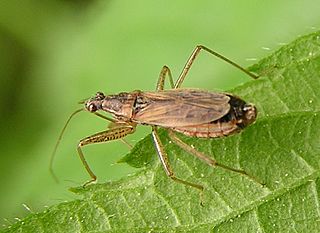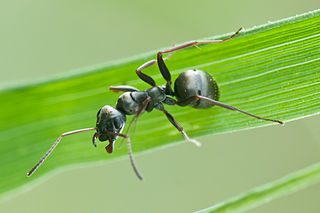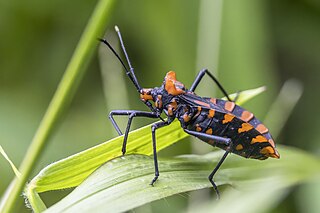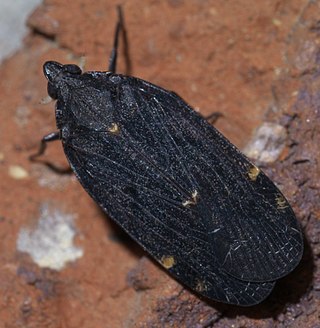
The insect family Nabidae contains the damsel bugs. There are over 500 species in 20 genera. They are soft-bodied, elongate, winged terrestrial predators. Many damsel bugs catch and hold prey with their forelegs, similar to mantids. They are considered helpful species in agriculture because of their predation on many types of crop pests.

The Philippine Atmospheric, Geophysical and Astronomical Services Administration is the National Meteorological and Hydrological Services (NMHS) agency of the Philippines mandated to provide protection against natural calamities and to ensure the safety, well-being and economic security of all the people, and for the promotion of national progress by undertaking scientific and technological services in meteorology, hydrology, climatology, astronomy and other geophysical sciences. Created on December 8, 1972, by reorganizing the Weather Bureau, PAGASA now serves as one of the Scientific and Technological Services Institutes of the Department of Science and Technology.

Formica fusca is a black-colored ant commonly found throughout Europe as well as parts of southern Asia and Africa. It has the common names silky ant or dusky ant. The range within the palaearctic region extends from Portugal in the west to Japan in the east and from Italy in the south to Fennoscandia in the north. Populations from North America have been split off as a separate species, Formica subaenescens. F. fusca nests are usually found in rotten tree stumps or under stones in clearcut areas and along woodland borders and hedgerows. The species also often occurs in urban areas, feeding on honeydew secreted by the aphids found on weeds.

The brown marmorated stink bug is an insect in the family Pentatomidae, native to China, Japan, Korea, and other Asian regions. In September 1998, it was collected in Allentown, Pennsylvania, where it is believed to have been accidentally introduced. The nymphs and adults of the brown marmorated stink bug feed on over 100 species of plants, including many agricultural crops, and by 2010–11 had become a season-long pest in orchards in the Eastern United States. In 2010, in the Mid-Atlantic United States, $37 million in apple crops were lost, and some stone fruit growers lost more than 90% of their crops. Since the 2010s, the bug has spread to countries such as Georgia and Turkey and caused extensive damage to hazelnut production. It is now established in many parts of North America, and has recently become established in Europe and South America.

The 2020 Pacific typhoon season was the first of an ongoing series of below average Pacific typhoon seasons, and became the first with below-average tropical cyclone activity since 2014, with 23 named storms, 10 of which became typhoons and only 2 became super typhoons. This low activity was a consequence of La Niña that persisted from the summer of the year. It had the fifth-latest start in the basin on record, slightly behind 1973, and was the first to start that late since 2016. The first half of the season was unusually inactive, with only four systems, two named storms and one typhoon at the end of July. Additionally, the JTWC recorded no tropical cyclone development in the month of July, the first such occurrence since reliable records began. The season's first named tropical cyclone, Vongfong, developed on May 8, while the season's last named tropical cyclone, Krovanh, dissipated on December 24. However, the season's last system was an unnamed tropical depression which dissipated on December 29.

Prostemmatinae is a subfamily of damsel bugs in the family Nabidae.

Taeniopteryx is a genus of winter stoneflies in the family Taeniopterygidae. There are more than 20 described species in Taeniopteryx.

Perlesta is a genus of common stoneflies in the family Perlidae. There are more than 30 described species in Perlesta.
Agathidium depressum is a species of round fungus beetle in the family Leiodidae. It is found in North America. It feeds on Stemonitis fusca

Spartocera is a genus of leaf-footed bugs in the family Coreidae. There are about 18 described species in Spartocera.

Erythrodiplax fusca, the red-faced dragonlet, is a species of skimmer in the dragonfly family Libellulidae. It is found in Central America, North America, and South America.
Phyllophaga fusca, the northern June beetle, is a species of scarab beetle in the family Scarabaeidae. It is found in North America.
Haplusia is a genus of gall midges and wood midges in the family Cecidomyiidae. There are more than 20 described species in Haplusia.
Dictyssa is a genus of tropiduchid planthoppers in the family Tropiduchidae. There are about 17 described species in Dictyssa.

Scytodes fusca, the brown spitting spider, is a species of spitting spider in the family Scytodidae. It is found in Central and Southern America, has been introduced into Europe, tropical Africa, Seychelles, Myanmar, China, Japan, and Hawaii.
Spartocera fusca is a species of leaf-footed bug in the family Coreidae. It is found in the Caribbean Sea, Central America, North America, and South America.
Pagasa is a genus of damsel bugs in the family Nabidae. There are about 11 described species in Pagasa.

Holcocephala fusca, the gnat ogre, is a species of robber fly in the family Asilidae.
Osbornia arborea is a species of tropiduchid planthopper in the family Tropiduchidae. It is found in North America.

Cixidia is a genus of true bugs belonging to the family Achilidae.












